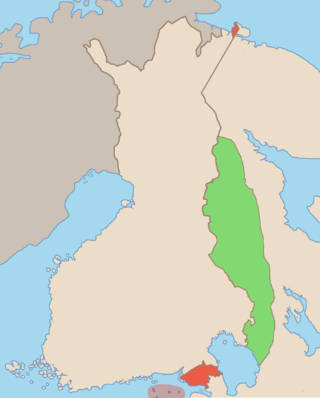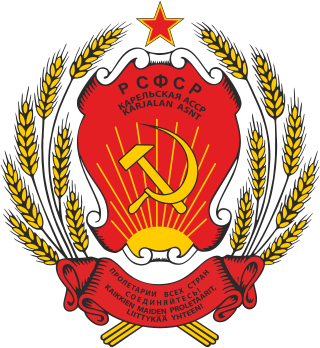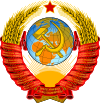
The Republics of the Union of Soviet Socialist Republics or the Union Republics were national-based administrative units of the Union of Soviet Socialist Republics (USSR). The Soviet Union was formed in 1922 by a treaty between the Soviet republics of Byelorussia, Russian SFSR (RSFSR), Transcaucasian Federation, and Ukraine, by which they became its constituent republics of the Union of Soviet Socialist Republics.

The State Flag of the Union of Soviet Socialist Republics, or simply the Soviet flag, was a red banner with two communist symbols displayed in the canton: a gold hammer and sickle topped off by a red five-point star bordered in gold. The flag's design and symbolism are derived from several sources, but emerged during the Russian Revolution. It has also come to serve as the standard symbol representing communism as a whole, recognized as such in international circles, even after the dissolution of the Soviet Union in 1991.

The hammer and sickle is a communist symbol representing proletarian solidarity between agricultural and industrial workers. It was first adopted during the Russian Revolution at the end of World War I, the hammer representing workers and the sickle representing the peasants.

The Karelo-Finnish Soviet Socialist Republic, also called Soviet Karelia or simply known as Karelia, was a republic of the Soviet Union. It existed from 1940 until it was made part of the Russian SFSR in 1956 as the Karelian Autonomous Soviet Socialist Republic. The latter became the Republic of Karelia, a federal subject of Russia, on 13 November 1991.

The Finnish Democratic Republic, also known as the Terijoki Government, was a short-lived communist puppet state of the Soviet Union in occupied Finnish territory from December 1939 to March 1940.

A red star, five-pointed and filled, is a symbol that has often historically been associated with communist ideology, particularly in combination with the hammer and sickle, but is also used as a purely socialist symbol in the 21st century. It has been widely used in flags, state emblems, monuments, ornaments, and logos.

The coat of arms of Russia derives from the earlier coat of arms of the Russian Empire. Though modified more than once since the reign of Ivan III (1462–1505), the current coat of arms is directly derived from its medieval original, with the double-headed eagle having Byzantine and earlier antecedents. The general tincture corresponds to the fifteenth-century standard.

The emblems of the constituent republics of the Union of Soviet Socialist Republics all featured predominantly the hammer and sickle and the red star that symbolized communism, as well as a rising sun, surrounded by a wreath of wheat. The USSR State motto, Workers of the world, unite!, in both the republic's language and Russian was also placed on each one of them. In addition to those repetitive motifs, emblems of many Soviet republics also included features that were characteristic of their local landscapes, economies or cultures.

The coat of arms of the Russian Republic of Karelia is crossed in three equal parts with the colors of the flag of Karelia on a shield with a profile of a rampant black bear. The golden frame of the shield comes into stylized image of a fir tree on the left and a pine tree on the right. In the upper part of the shield there is an octagonal star of gold. The arms were created by Yu. S. Nivin.

The Karelian Autonomous Soviet Socialist Republic, Karelian ASSR for short, sometimes referred to as Soviet Karelia or simply Karelia, was an autonomous republic of the Russian SFSR, Soviet Union, with the capital in Petrozavodsk.

The State Anthem of the Karelo-Finnish SSR was the national anthem of Karelia when it was a republic of the Soviet Union and known as the Karelo-Finnish SSR.

The flag of the Karelo-Finnish SSR was adopted by the Karelo-Finnish SSR on 3 March 1953. This flag is similar to the flag of the Soviet Union but with the blue, and green placed on the bottom. At the top of the flag at the flagpole placed golden hammer and sickle and the red star with a gold border. The green color symbolizes the forest resources, and blue represents the abundance of rivers and lakes.

The coat of arms of the Kirghiz Soviet Socialist Republic was adopted on March 23, 1937, by the government of the Kirghiz Soviet Socialist Republic. The coat of arms is based on the coat of arms of the Soviet Union. It shows symbols of agriculture on a backdrop of the Ala-Too mountain ranges, surrounded by a frame of folk art of the Kyrgyz people. The red star was added in 1948. The rising sun stands for the future of the Kyrgyz nation, the star as well as the hammer and sickle for the victory of communism and the "worldwide socialist community of states".

Socialist-style emblems usually follow a unique style consisting of communist symbolism. Although commonly referred to as coats of arms, most are not actually traditional heraldic achievements. Many communist governments purposely diverged from heraldic tradition in order to distance themselves from the monarchies that they usually replaced, with coats of arms being seen as symbols of the monarchs.
Pavel Stepanovich Prokkonen, born Prokofiev, was a Karelian Soviet politician. He was appointed as the Chairman of the Council of the People's Commissars of the Karelo-Finnish Soviet Socialist Republic (1940–1947) and Chairman of the Council of Ministers of the Karelo-Finnish Soviet Socialist Republic (1950–1956). Prokkonen was also the Minister of Karelian Affairs for the Finnish Democratic Republic during the Winter War in 1940

The State Emblem of the Soviet Union was adopted in 1923 and was used until the dissolution of the Soviet Union in 1991. Although it technically is an emblem rather than a coat of arms, since it does not follow traditional heraldic rules, in Russian it is called герб, the word used for a traditional coat of arms.
The coat of arms of Karelia may refer to

The emblem of the Russian Soviet Federative Socialist Republic (RSFSR) was adopted on 10 July 1918 by the government of the Russian Soviet Federative Socialist Republic, and modified several times afterwards. It shows wheat as the symbol of agriculture, a rising sun for the future of the Russian nation, the red star as well as the hammer and sickle for the victory of communism and the "world-wide socialist community of states".
Communist symbolism represents a variety of themes, including revolution, the proletariat, the peasantry, agriculture, or international solidarity. The red flag, the hammer and sickle and the red star or variations thereof are some of the symbols adopted by communist movements, governments, and parties worldwide.

The national emblem of the Karelian Autonomous Soviet Socialist Republic was adopted in 1937 by the government of the Karelian Autonomous Soviet Socialist Republic. The emblem is identical to the emblem of the Russian Soviet Federative Socialist Republic.


















